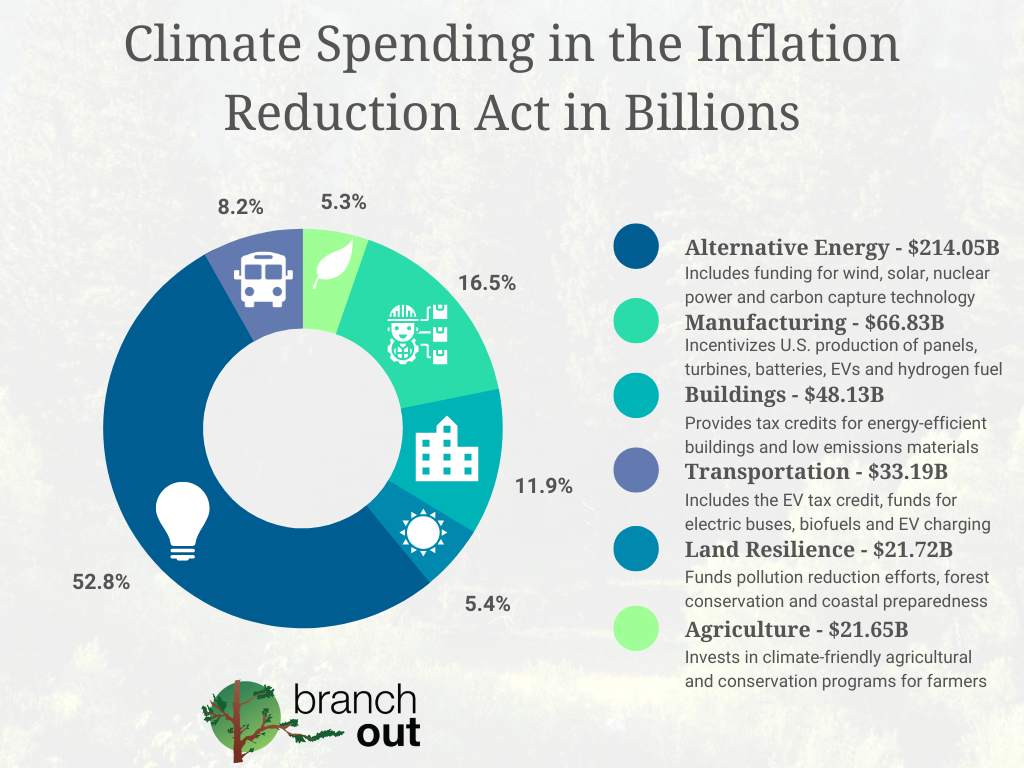This is a developing story. Check back for updates.
The U.S. House of Representatives voted 220 to 207 today, passing the Inflation Reduction Act (IRA) along partisan lines. The bill, which passed the Senate on Sunday now heads to President Biden’s desk to be signed into law. The spending package focuses on climate, prescription drug pricing for Seniors, and various tax reforms. In total, it authorizes $739 billion in spending over 10 years, but it actually reduces the federal government budget deficit by $100 billion via establishing minimum corporate tax rates.
The climate change portion of the legislation has drawn mixed reactions from environmental groups and communities at the frontlines of the climate crisis. The Inflation Reduction Act will reduce U.S. emissions 40% from 2005 levels, according to an Energy Innovation report. While the bill has been praised as the most significant investment ever made to transition the U.S. electrical grid from fossil fuels to cleaner energy sources, the bill has also been criticized for not going far enough and for also potentially fast-tracking additional fossil fuel infrastructure such as drilling on federal land and water, pipelines and oil and gas export terminals.
Fossil Fuel Giveaways
In order to get the Inflation Reduction Act through the U.S. Senate, the Democrats had to appease their most conservative members, Senators Joe Manchin (D-WV) and Kyrsten Sinema (D-AZ). Manchin in particular worked to undermine the climate goals by ensuring that the fossil fuel industry received benefits from the legislation. Manchin has made hundreds of thousands of dollars from his son’s coal business, and he has received more than $800,000 in campaign donations from the fossil fuel industry so far this election cycle, according to OpenSecrets.org.
In a move that the Center for Biological Diversity described as a “Manchin Poison Pill,” the legislation requires that the federal government offer leases for oil and gas drilling in order to also offer leases for wind or solar projects on federal land or water. The bill would require 600 million acres of federal waters to open for offshore drilling over ten years in order to continue with the construction of offshore wind.
“The bill would require the Interior Department to offer at least 2 million acres of public lands and 60 million acres of offshore waters for oil and gas leasing each year for a decade as a prerequisite to installing any new solar or wind energy. If the department failed to offer these minimum amounts for leasing, no right of ways could be granted for any utility-scale renewable energy project on public lands or waters,” said the Center for Biological Diversity in a press release. More than 350 conservation and community groups signed a letter urging Democrats to drop this requirement, but they were ignored.
Manchin is also reportedly working on a side-deal weakening environmental review requirements for permitting fossil fuel infrastructure projects such as pipelines and export terminals. Although this deal is not built directly into the Inflation Reduction Act, the side deal is expected to be pushed through Congress next month and could fast-track fossil fuel projects such as the Mountain Valley Pipeline, which goes through West Virginia, and the Enbridge gas export terminal that would destroy a sacred Karankawa Kadla site in Texas.
Climate-Related Spending
In total, the IRA invests more than $400 billion into climate-related projects, mainly in the form of tax credits for private companies and consumers. The majority of this money aims to boost the amount of wind and solar energy in the U.S. grid by giving tax credits to renewable energy producers delivering power to the grid, as well as companies manufacturing batteries and wind and solar power components.

Although the amount of climate-related spending has been reported as $370 billion, the actual number will be about $406 billion according to a breakdown of the bill provided to Branch Out by the BlueGreen Alliance, a solutions-oriented group that aims to unite labor and environmental organizations.
“This bill will create good-paying union jobs across the country while driving down the emissions causing climate change. It will be a game-changer in growing clean energy, revitalizing manufacturing, and building resilient communities,” said BlueGreen Alliance’s Executive Director Jason Walsh in a statement. The group estimates that the Inflation Reduction Act will create 9 million jobs over the next ten years.
Cleaning up the Grid
The single biggest impact of the IRA is that it will incentivize energy providers to invest in cleaner forms of energy such as wind and solar. In total, those tax incentives are estimated at $127 billion to make these investments more lucrative. More than half the job creation resulting from the Inflation Reduction Act will be in the clean energy industry, according to the BlueGreen Alliance.
Additionally, $30 billion in the IRA will incentivize the production of nuclear power by extending a tax credit that rewards nuclear power companies for the energy they supply to the grid. Although nuclear power does not produce any greenhouse gasses, it does produce radioactive waste that lasts millions of years and damages the health of humans and ecosystems. Although they may be relatively safe if the waste is safely stored, history shows Nuclear power plants are vulnerable to natural disasters such as the tsunami that caused the Fukushima meltdown in Japan, or man-made disasters such as the war in Ukraine which currently threatens the Zaporizhzhia Nuclear plant as Russian and Ukrainian soldiers have been fighting nearby, according to Democracy Now.
The bill also includes funding for rural electric co-ops and adding additional transmission lines. Adding transmission lines will improve the efficiency of existing wind and solar power. In many areas across the country that have large amounts of solar and wind generating capacity, such as Northwest Texas, the transmission capacity has not kept up so some of that energy is wasted.
Transportation
One of the major transportation initiatives in the IRA is the $4,000 and $7,500 rebates for used and new electric vehicles. For qualifying individuals and families, these rebates will help make electric vehicles more affordable. The bill, however, has zero funding for building high-speed rail or directly expanding public transit, although it contains components that may incentivize the production of electric buses.
The original Build Back Better Act, on the other hand, would have invested $10 billion each in building high-speed rail and in improving public transportation to allow for increased mobility in urban areas without requiring the use of a car. The auto-focused approach of the IRA has been criticized by public transportation advocates including the group Transportation for America.
“Most of the infrastructure funds included in this bill represent the same broken status quo approach that led to such high transportation emissions in the first place. Transit is entirely absent. … We need electric vehicles, and we need to drive less overall. The Inflation Reduction Act invests heavily in the former while ignoring the latter,” wrote Abigail Grimminger of Transportation for America, in a blog post.
The IRA also includes funding for the development of low-emissions aviation fuel, grants for reducing emissions at ports and shipping channels, building electric vehicle charging stations and production of alternative fuels, or biofuels. Biofuels, however, have been criticized as a greenwashing technique that allows companies to continue building gas infrastructure rather than investing in clean electric alternatives.
Manufacturing and Construction
The manufacturing portion of the IRA also focuses primarily on clean energy with the goal of bringing the supply chain for clean energy technology to the United States rather than relying on the manufacturing capacity of other countries such as China. Additionally, about $13 billion will go toward the development of hydrogen fuel, and this provision has been the target of criticism due to possible unintended consequences of burning hydrogen fuel.
A recent study by the Environmental Defense Fund highlighted that hydrogen fuel “could be worse for the near-term climate than the fossil fuels it would replace” because “hydrogen leaks increase the amounts of other greenhouse gases such as methane, ozone and water vapor.” While the industry promises that leaks will be minimized, the strong emphasis on hydrogen in the IRA is a key part of what won over Manchin, who is seeking to use fossil fuel infrastructure and production in West Virginia as the basis for one of four national hubs for the production of “clean hydrogen.” It has also won the support of U.S. oil giants, such as Exxon Mobil’s CEO who applauded the IRA’s hydrogen tax credit and Chevron which is planning to invest $2.5 billion in hydrogen over the next decade.
The IRA will make it easier to build energy-efficient buildings that employ various water conservation techniques. It does this through tax credits and rebates that are also aimed at making energy-efficient appliances more affordable for the average person. The $48 billion that goes toward buildings will largely benefit private consumers and developers who choose to use energy-efficient features. The bill did not include any money for public buildings like schools, which were proposed to receive about $80 billion in the original Build Back Better Act.
Land and Agriculture
Sustainable farmers can also benefit from the Inflation Reduction Act. $21 billion goes to fund various programs within the Department of Agriculture that reward farmers who employ techniques that will increase the carbon storage capacity of the soil. The programs help farmers plant cover crops, put up fences to prevent overgrazing, and the influx of funding will make the programs more accessible to farming communities.
Black farmers, however, have pushed back on this approach which opens grants which used to be exclusively for Black farmers to repair decades of antiblack discrimination up to the entire farming community. John Boyd, President of the National Black Farmers Association told the New York Times that President Biden “went back on his commitment to help Black farmers.” The original program faced legal challenges from white farmers and banks, and now any farmer who can prove to the government that they experienced discrimination may qualify for the program.
Another $26 billion goes to various pollution cleanup efforts as well as land and water conservation. This money includes block grants meant to benefit environmental justice causes cleaning up communities that have been most impacted by pollution from the fossil fuel and petrochemical industries. The Build Back Better Act had proposed about $79 billion for these projects, including $30 billion for a Civilian Climate Corps jobs program that would employ people on pollution cleanup and conservation projects. The program was completely scrapped from the Inflation Reduction Act.
The Path Forward
The dominant narrative in the climate action community was expressed by Drilled podcast host Amy Westervelt who concluded her summary of the Inflation Reduction Act by writing “it’s a helluva lot better than nothing.” There is also a general agreement that the IRA should have gone further, and the fight for bolder action continues.
“Today, we celebrate the power of organizing. But the science of the climate crisis does not grade on a curve – and it’s clear that the IRA is not enough,” said Sunrise Movement Executive Director Varshini Prakash in a statement. “As Americans across the country suffer right now from record flooding, crippling droughts, and deadly heat waves, we need President Biden, Congress, and elected officials at every level of office to treat this crisis like the emergency that it is.”
Perhaps the harshest criticism of the Inflation Reduction Act came from Indigenous People who have been resisting the expansion of fossil fuel infrastructure on their sacred land. In an interview with Democracy Now, Tara Houska, an Indigenous lawyer and founder of the Giniw Collective who has been fighting the Enbridge Line 3 pipeline, said: “it’s doubling down on fossil fuels to get to renewables. And even the renewables, we have to acknowledge the fact that renewables themselves, it’s still going to be extraction. It’s still going to be the model that the fossil fuel and extractive industry wants, which is new mines in new places, which means our people, Indigenous people, which means Black and Brown people continue to disparately experience the effects of extractive industry. It means that mining companies are showing up in our backyard.”




